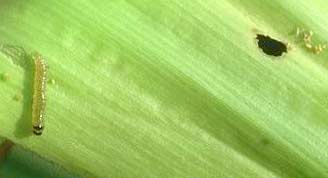
European corn borer larvae are flesh-colored with inconspicuous, light brown spots down the body. They are about one inch long when full-grown. Adult female moths are pale yellow-brown with irregular, wavy, dark bands across the wings. Males are distinctly darker with olive brown markings on the wings. The moths are strong fliers, active at night. Masses of 20 to 30 eggs are laid on the underside and near the midrib of whorl leaves. The larvae move to the whorl where they feed for about 3 weeks. They pupate in or on the plant. There are 2 generations each year. A partial 3rd generation can occur during some seasons.
Corn borers cause damage in two major ways. First, tunneling in the stalk reduces water and nutrient flow and contributes to physiological yield loss. This is the primary cause of yield reduction. Damaged plants are not able to produce to their full potential. Second, borers produce cavities in the plant which weaken it. Stalk breakage and ear drop, prior to harvest, can lower yields. Also, the exit holes that the larvae chew in corn stalks for adult emergence allow the entry of stalk rot pathogens, which also can weaken the plant before harvest. Additional damage can occur when second generation borer larvae enter the ear and feed directly on kernels.
1st GENERATION: Treatment for first generation European corn borers may be
recommended if 25% of the plants show fresh 'window pane' feeding damage and live larvae are present. Infestations
are generally higher in early planted popcorn. A computer model accurately predicts when to look for damage. Contact
your county extension agent for this information and a copy of
ENT- 49, European Corn borers in Corn.
This publication
will allow a more accurate estimate of potential yield loss and will aid in making control decisions.
2nd GENERATION: The second generation of European corn borers is usually only a problem
for late-planted popcorn. Control with insecticides is difficult and rarely justified. Early harvest is a way to reduce losses due
to stalk breakage in fields that are heavily infested.
| Insecticide | Rate per Acre | Notes |
| Ambush 2 E | 6.4 - 12.8 fl oz | Apply prior to brown silk |
| Asana XL | 7.8 to 9.6 fl oz | 1 day PHI |
| Bt products | See Biobit, Dipel, Javelin, or Lepinox labels for specific rates | |
| Capture 2EC | 2.1 to 6.4 fl oz | 30 day PHI |
| Lorsban 15% G | 5 to 6.5 lbs | 35 day PHI; 14 day fodder |
| Lorsban 4 E | 1.5 to 2 pints | 35 day PHI; 14 day fodder |
| Mustang Max | 2.72 to 4.0 fl oz | 30 day grain, 60 day silage PHI |
| Penncap-M | 2 to 4 pints | 12 day PHI |
| Pounce 3.2 EC | 4 to 8 fl oz | Apply prior to brown silk |
| Pounce 1.5% G | 6.7 to 13.3 lbs | 30 day PHI |
| Sevin 80 S | 1-7/8 to 2-1/2 lbs | 14 day PHI |
| Tracer 4SC | 1 to 3 fl oz | 28 day PHI |
| Warrior T | 2.56 to 3.84 fl oz | 21 day PHI |
See ENTFACT - 106, Predicting European Corn Borer Development for more information.